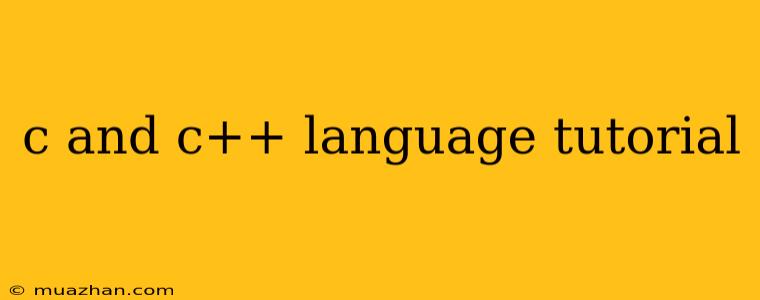C and C++ Language Tutorial: A Comprehensive Guide
C and C++ are powerful programming languages that have been used to develop a wide variety of software, including operating systems, game engines, and embedded systems. They are known for their performance, flexibility, and low-level access to hardware.
This tutorial will provide a comprehensive overview of C and C++, covering the fundamentals of both languages, including:
C Language
1. Introduction to C
- History and Background: Learn about the origins of C and its impact on modern programming.
- Key Features of C: Understand the fundamental characteristics that make C a powerful language.
- Setting Up Your Development Environment: Configure your computer to write and run C programs.
2. Basic Syntax and Data Types
- Variables and Data Types: Declare variables and assign values to them using different data types (int, char, float, etc.).
- Operators: Learn about arithmetic, relational, logical, and bitwise operators.
- Control Flow Statements: Understand how to control the flow of execution with if-else statements, loops, and switch statements.
3. Functions and Modules
- Defining and Calling Functions: Create reusable blocks of code to perform specific tasks.
- Function Arguments and Return Values: Pass data to functions and receive results.
- Function Prototypes and Header Files: Organize your code into modular components.
4. Pointers and Memory Management
- Understanding Pointers: Learn how pointers work and their use in accessing memory locations directly.
- Dynamic Memory Allocation: Allocate memory during runtime using functions like malloc() and free().
- Arrays and Strings: Work with arrays and strings, including pointer-based manipulation.
5. File Input/Output
- Working with Files: Open, read, write, and close files using standard input/output functions.
- File Pointers and File Operations: Control the file cursor and perform various operations on files.
6. Structures and Unions
- Defining Structures: Create custom data types to group related variables.
- Accessing Structure Members: Access individual elements of structures.
- Unions: Understand the concept of unions and their applications.
7. Preprocessor Directives
- #include: Include header files to access pre-defined functions and macros.
- #define: Define constants and macros for code readability and efficiency.
- Conditional Compilation: Control which parts of the code get compiled based on specific conditions.
C++ Language
1. Introduction to C++
- Object-Oriented Programming (OOP): Learn the principles of OOP, including encapsulation, inheritance, and polymorphism.
- C++ as an Extension of C: Understand the relationship between C and C++ and how C++ extends C's capabilities.
2. Classes and Objects
- Defining Classes: Create blueprints for objects, specifying data members and member functions.
- Creating Objects: Instantiate objects from classes.
- Encapsulation and Data Hiding: Protect data members and control access to them.
3. Inheritance and Polymorphism
- Inheritance: Create new classes that inherit properties and methods from existing classes.
- Polymorphism: Implement different behaviors for the same function call based on the object type.
4. Constructors and Destructors
- Constructors: Initialize objects when they are created.
- Destructors: Clean up resources when objects are destroyed.
5. Operator Overloading and Function Overloading
- Operator Overloading: Redefine the behavior of operators for user-defined types.
- Function Overloading: Define multiple functions with the same name but different parameters.
6. Templates and Generic Programming
- Templates: Create reusable code that can work with different data types.
- Generic Programming: Write code that is independent of specific data types.
7. Standard Template Library (STL)
- Containers: Store and manage data in various ways, such as vectors, lists, and maps.
- Iterators: Traverse through containers to access elements.
- Algorithms: Perform operations on containers, such as sorting, searching, and transforming data.
This tutorial is just a starting point for your journey into C and C++. By mastering these fundamentals, you will be well-equipped to explore more advanced concepts and develop powerful applications. Remember, practice is key to becoming proficient in any programming language.
